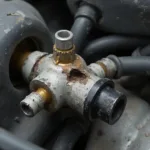The dreaded P0401 OBD2 code indicates a problem with your vehicle’s Exhaust Gas Recirculation (EGR) system. Specifically, it means the car’s computer has detected insufficient EGR flow. This article provides a comprehensive guide to understanding, diagnosing, and potentially fixing the P0401 code, helping you get back on the road quickly and efficiently.
The P0401 code can be a frustrating issue for car owners. It can lead to decreased fuel economy, increased emissions, and potentially even damage to your engine. Understanding what causes this code and how to address it is essential for maintaining your vehicle’s health and performance. We’ll cover everything from the basics of the EGR system to advanced troubleshooting techniques, empowering you to take control of your car’s maintenance.
What is the EGR System and Why is it Important?
The EGR system plays a crucial role in reducing harmful nitrogen oxide (NOx) emissions. It does this by recirculating a small amount of exhaust gas back into the intake manifold, effectively lowering combustion temperatures. This reduces the formation of NOx, which contributes to smog and air pollution.
How the EGR System Works
The EGR system typically consists of an EGR valve, a vacuum modulator (in older systems), and various sensors and passages. The EGR valve opens and closes to control the flow of exhaust gas. The engine control module (ECM) monitors various engine parameters, such as engine load and temperature, to determine when and how much exhaust gas to recirculate.
Common Causes of the P0401 Code
Several issues can trigger the P0401 code. Here are some of the most common culprits:
- Blocked or Clogged EGR Valve: Carbon buildup can restrict the EGR valve’s movement, preventing it from opening and closing properly.
- Faulty EGR Vacuum Modulator: In older vehicles, a malfunctioning vacuum modulator can disrupt the vacuum signal needed to operate the EGR valve.
- Restricted EGR Passages: Carbon deposits can also clog the passages that carry exhaust gas to and from the EGR valve.
- Faulty DPFE Sensor (Differential Pressure Feedback EGR Sensor): This sensor monitors the EGR flow and provides feedback to the ECM. A faulty DPFE sensor can provide inaccurate readings, leading to the P0401 code.
- Wiring Problems: Damaged or corroded wiring in the EGR system can disrupt communication between the various components.
Diagnosing and Fixing the P0401 Code
Diagnosing the P0401 code requires a systematic approach. Here’s a step-by-step guide to help you pinpoint the problem:
- Check for Vacuum Leaks: Inspect the vacuum hoses connected to the EGR system for cracks or leaks.
- Inspect the EGR Valve: Remove the EGR valve and check for carbon buildup. Clean the valve thoroughly with carburetor cleaner.
- Test the EGR Vacuum Modulator (if applicable): Apply vacuum to the modulator and check for proper operation.
- Check the DPFE Sensor: Inspect the sensor for damage or contamination. You may need a multimeter to test its electrical signals.
- Check the Wiring: Inspect the wiring harness for any damage or corrosion.
What Does the P0401 Code Mean?
The P0401 code specifically indicates “Exhaust Gas Recirculation Flow Insufficient Detected.” This means the ECM has determined that the amount of exhaust gas being recirculated is less than what it should be.
How to Prevent Future P0401 Codes
Regular maintenance can help prevent future P0401 codes. Here are some preventative measures:
- Regularly Clean the EGR Valve: Remove and clean the EGR valve every few years or as recommended in your vehicle’s maintenance schedule.
- Use High-Quality Fuel: Using quality fuel can help reduce carbon buildup.
- Ensure Proper Engine Operation: Addressing other engine issues promptly can prevent strain on the EGR system.
Expert Insight from John Miller, Certified Master Automotive Technician:
“The P0401 code is a common issue, but it’s often easily resolved with a thorough cleaning of the EGR valve and passages. Regular maintenance can significantly extend the life of your EGR system and prevent costly repairs.”
Conclusion
The OBD2 code P0401, indicating insufficient EGR flow, can be a manageable issue if addressed promptly and correctly. By understanding the EGR system and following the diagnostic steps outlined in this article, you can effectively troubleshoot and resolve the P0401 code, keeping your vehicle running smoothly and efficiently. Remember to prioritize regular maintenance to prevent future occurrences of this code.
FAQ
-
Can I drive with a P0401 code? While you can technically drive with this code, it’s not recommended. It can lead to reduced fuel efficiency and increased emissions.
-
How much does it cost to fix a P0401 code? The cost can vary depending on the specific issue. Cleaning the EGR valve can be a relatively inexpensive fix, while replacing the entire EGR system can be more costly.
-
Can I clean the EGR valve myself? Yes, cleaning the EGR valve is a relatively straightforward DIY project.
-
What tools do I need to clean the EGR valve? You’ll need basic hand tools, carburetor cleaner, and possibly a gasket scraper.
-
How often should I clean the EGR valve? Every few years or as recommended in your vehicle’s maintenance schedule.
-
What other codes are related to the EGR system? P0400, P0402, P0403, P0404, P0405, and P0406 are all related to the EGR system.
-
Can a bad EGR valve cause rough idling? Yes, a malfunctioning EGR valve can disrupt the engine’s idle.
Common Scenarios for P0401 Code
- Scenario 1: Engine light comes on, and the car feels sluggish.
- Scenario 2: Reduced fuel economy and increased emissions.
- Scenario 3: Rough idling and hesitation during acceleration.
Further Reading
- Check out our article on obd2 code 040 for more information.
Need help? Contact us via WhatsApp: +1(641)206-8880, Email: [email protected] or visit us at 789 Elm Street, San Francisco, CA 94102, USA. We have a 24/7 customer support team.
